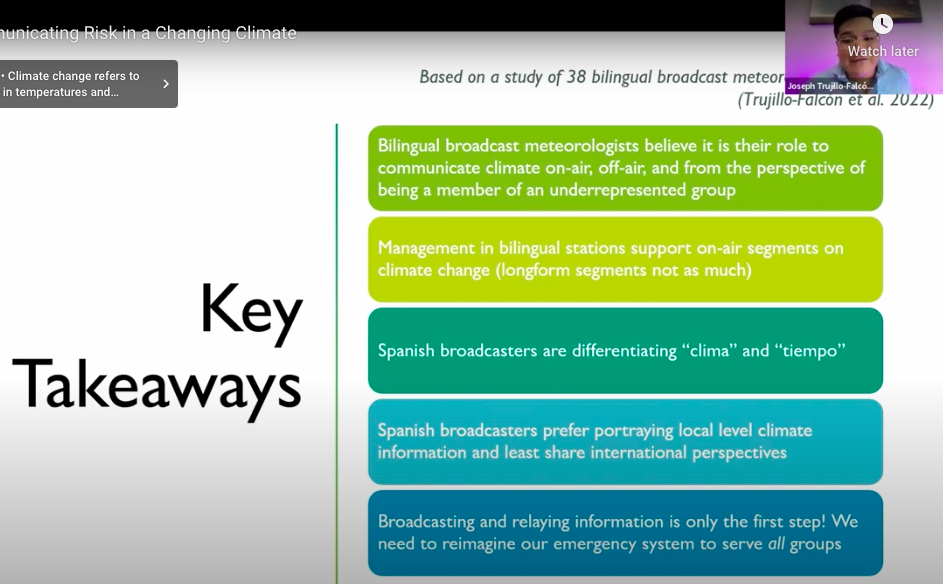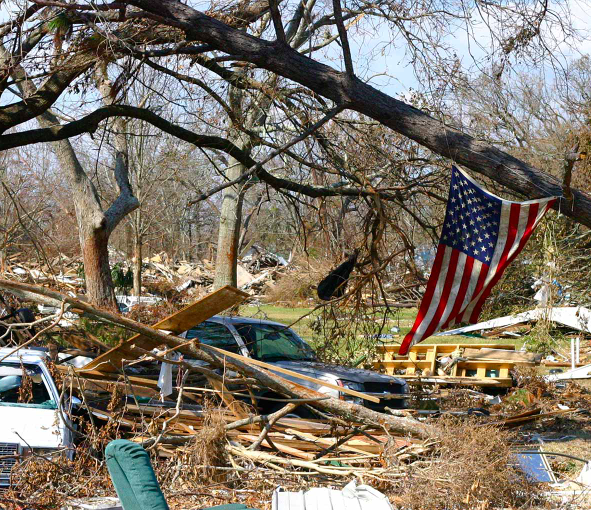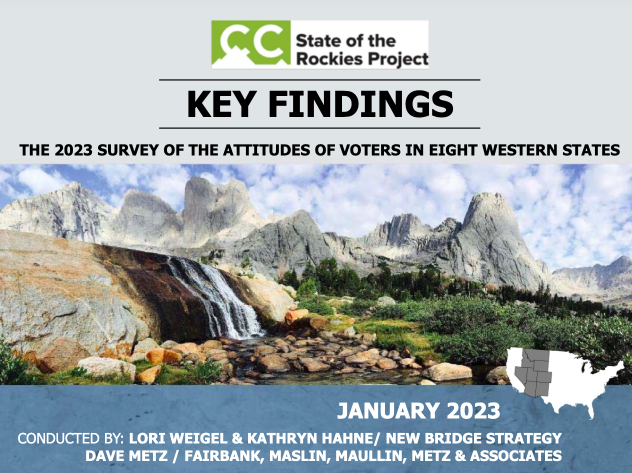Resources
Search below for resources covering the intersection of climate engagement, social science and data analytics.
RESULTS
The effects of climate change on public health couldn’t be clearer. The 10 hottest years on record have all occurred since 2010. In fact, 2022 marked the eighth year in a row that average global temperatures were 34 degrees higher than pre-industrial (1850-1900) average temperatures. Rising sea levels, compromised air and water quality, and the increasing frequency of extreme weather events all speak to the stark reality that the climate is changing. Drought and excessive rainfall offer stark examples of how climate change affects public health. This can lead to rising prices, which can exacerbate food insecurity and lead to malnutrition. Air pollution can cause temporary irritation to the eyes and respiratory tract and trigger asthma attacks. However, air pollution can have much longer-lasting health effects as well: Once in the bloodstream, these harmful substances can circulate through the whole body, causing inflammation, suppressing the immune system, and disrupting the ability of biological systems to detoxify. Severe storms, such as hurricanes and blizzards, pose immediate dangers to affected communities. Compared to an average of two heat waves occurring every year in the 1960s, today, an average of six occur every year. Education, preparation and monitoring, identification and monitoring, and climate adaptation and resilience plans are key to responding to climate public health threats.
Global Change Seminar Summary: Communicating Risk in a Changing Climate
For weather information to effectively reach the public, that information must be received, understood, trusted, and prompt a response from the audience. There is no singular method that can be used to reach all audiences – practitioners should vary their strategies to reach multiple demographics. Bilingual and Spanish-speaking broadcasters are playing a critical role in communicating climate and weather information with underrepresented groups. When you have risk information to share with your audience, consider following the “27-9-3” model: limit your message to contain no more than 27 words, which can be delivered in 9 seconds, and has just 3 main ideas. Audiences’ perceptions of risk are context-dependent and will vary substantially – there is no such thing as a “general audience” when it comes to risk communication. This resource includes a video recorded panel of 3 experts on these topics.
Roughly three in four Americans recognize that climate change is happening, and most believe it’s accelerating. Extreme weather and scientists have the greatest influence on Americans’ climate views. 74% of Americans recognize that climate change is happening. 55% of Americans say that the pace of climate change is getting faster. 41% percent of Americans say they would be at least somewhat likely to purchase an electric vehicle (EV) the next time they are in the market for a new car, according to a new survey from the Energy Policy Institute at the University of Chicago (EPIC) and The Associated Press-NORC Center for Public Affairs Research. More than 6 in 10 Americans cite saving money on gas and vehicle maintenance as reasons to purchase one, along with reducing their personal impact on climate change.
Poll: Nearly Half in South Recently Affected by Extreme Weather
Roughly one in three Americans say they’ve experienced extreme weather in the last two years, including nearly half of the South. However, few think of extreme temperatures when asked to provide examples of “extreme weather” events. Americans who say that winter in their area this season was warmer than usual (42% of Americans) are more likely to say that warmer winter temperatures are due to climate change (62%) than natural variation (36%).
Driving climate conversations in Australia with Ocean Visuals exhibition at the Sydney Opera House
The ocean is fundamental to the livelihoods of most Australians, 80% of which live in coastal zones. Ocean health and climate resilience are also deeply interlinked – the ocean is the world’s biggest carbon sink, absorbing a quarter of all carbon emissions. Climate change is causing serious shifts in the ocean, which is degrading its health and contributing to sea level rise and disaster risks, like storm surges and hurricanes. Climate Outreach teamed up with Australian agency Glider Global to root its global Ocean Visuals project in Australia. Climate Outreach display 32 images from their Ocean Visuals collection in a free exhibition at the Sydney Opera House between 29 March and 7 April. Several of the photographs selected from the Ocean Visuals collection, and photos taken over the course of the exhibition can be seen at the link.
Poll: Cooling Communities in a Warming Planet: Policies for Extreme Heat Mitigation
Voters are widely concerned about extreme heat - particularly in how it impacts the elderly - and support a wide range of policies to mitigate it. 87% of voters support their state or municipality investing in public urban green spaces, including parks and open areas with trees and other natural features, to reduce the urban heat island effect in cities. 85% of voters support their state or municipality providing financial incentives for installing energy-efficient air conditioning in homes. 84% of voters support their state or municipality investing in programs to weatherize homes to make them more energy efficient and climate resilient. 78% of voters support the Heating and Cooling Relief Act to increase annual funding for low-income household energy assistance and expand eligibility to ensure that no household pays more than 3 percent of its annual income on energy costs. 78% of voters support a federal law to prevent utility shut-offs during extreme heat events. 77% of voters support requiring landlords to provide renters with air conditioning or indoor cooling in areas that experience extreme heat events.
Climate Change in the American Mind: Beliefs & Attitudes, December 2022
The steady majority of Americans recognize that humans are causing global warming, and nearly half say that they’ve been personally impacted. Americans also tend to believe that global warming is affecting the weather, especially in the cases of extreme heat, droughts, and wildfires. Americans who recognize that global warming is happening outnumber those who deny that it’s happening by a greater than four-to-one margin (70% to 16%). 63% of Americans say they feel a personal sense of responsibility to help reduce global warming. Three in five Americans (60%) recognize that global warming is affecting weather in the United States; when asked about specific types of extreme weather, more than two-thirds agree that global warming is affecting extreme heat (70%), droughts (70%), wildfires (70%), and water shortages (68%). Nearly three in five Americans (58%) recognize that global warming is mostly caused by humans.
2023 Conservation in the West Poll
Residents of US western states continue to prioritize conservation of the land, water, wildlife, and their ability to enjoy the outdoors. People in New Mexico, Arizona, Colorado, Utah, Nevada, Montana, Wyoming, and Idaho were surveyed for this poll. 97% of westerners believe the rising cost of living is a serious issue, and 89% believe the price of gasoline is a serious issue. There has been a 28-point increase since 2016 in the share of westerners who say that people moving to their state is a serious problem (from 47% to 75%). 50% of westerns say that the current shortage of water in the west is a serious crisis. The plurality of westerners (38%) say that businesses use the most water in their state, as compared to farmers and ranchers (34%) and households (25%).
Environmental Polling Roundup - February 10th, 2023
This post includes climate and environment headlines, data points, and key takeaways from recent public polls - including new polling on the Inflation Reduction Act (IRA), climate and the environment as policy priorities, and the personal impacts of climate change.
Climate Change in the American Mind: Politics & Policy, December 2022
Americans’ climate attitudes are continuing to grow more polarized, but bipartisan majorities support clean energy and conservation efforts. 79% of voters support funding more research into renewable energy sources. 79% of voters support generating renewable energy on public lands. 68% of voters support increasing federal funding to low-income communities and communities of color who are disproportionately harmed by air and water pollution. 66% of voters support transitioning the U.S. economy from fossil fuels to 100% clean energy by 2050. 65% of voters say that developing sources of clean energy should be a “high” or “very high” priority for the president and Congress. 62% of voters support requiring electric utilities to produce 100% of their electricity from renewable energy sources by 2035. 55% of voters support a U.S. president declaring global warming a national emergency if Congress does not take further action.
Pagination
- Previous page
- Page 5
- Next page








